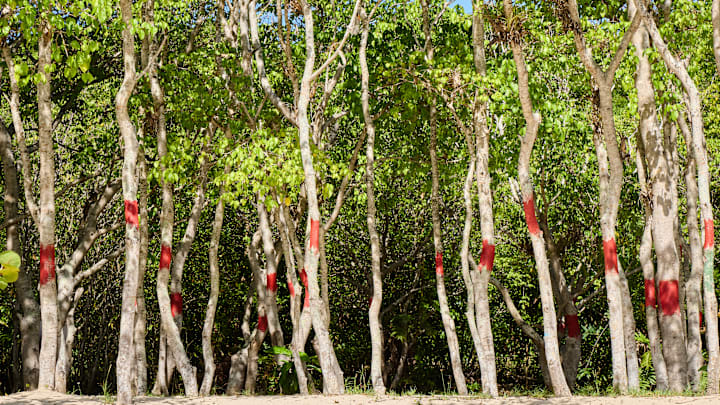When we think of poisonous plants, we might picture poison ivy, poison sumac, or poison oak. But those plants have nothing on this tropical tree. Found in parts of southern Florida, Central America, South America, and the Caribbean, the manchineel tree is the most dangerous tree on Earth, potentially causing temporary blindness from a single touch.
The Forbidden Fruit

The manchineel tree usually grows in clusters on beaches or in brackish water (water that is saltier than freshwater, yet less salty than seawater). It’s also quite majestic, reaching heights of up to 50 feet. The tree’s fruits give off a pleasant aroma capable of luring animals—and sometimes people.
According to Southern Living, the manchineel tree (also called the “tree of death”) got its name from the Spanish word manzanilla, meaning “little apple,” in reference to its round, green fruit. It’s also known as manzanilla de la muerte (translating to “little apple of death”) in Spanish-speaking parts of the world.
You May Also Like:
- 25 Worst U.S. Cities for Allergy Sufferers
- How the Return of Wolves to Yellowstone Helped Aspen Trees Thrive
- Do Oranges Make Your Lips Itch? Here's the Reason Why
What Can Happen If You Touch a Manchineel Tree?
There’s no safe way to approach a manchineel tree, as every part of it is toxic. One touch is enough to cause severe skin irritations and eye injuries that can leave you temporarily blind. Simply standing under a manchineel tree while its raining can even cause pain. It’s also a bad idea to burn its lumber, as the smoke is harmful as well.
The manchineel’s fruit is just as dangerous, and may even cause death. Some symptoms of ingesting it include:
- Blistering and swelling around the mouth and throat that can make it hard to breathe or swallow
- Cardiovascular issues, such as low blood pressure
- Digestive tract damage
- Vomiting
- Abdominal bleeding
- Dehydration
Some resilient animals, like the spiny-tailed iguana and the giant Galapagos tortoise, have adapted to withstand the poison. People who live within its range have also figured out how to safely use it to their advantage. Some carpenters in the Caribbean will harvest the manchineel’s wood, dry it in the sun to neutralize the sap, and use it to build furniture. There are also legends of hunters and warriors coating arrowheads with the deadly sap; one unconfirmed story alleges that the explorer Juan Ponce de León was killed this way.
